brake PONTIAC GRAND-AM 1995 User Guide
[x] Cancel search | Manufacturer: PONTIAC, Model Year: 1995, Model line: GRAND-AM, Model: PONTIAC GRAND-AM 1995Pages: 354, PDF Size: 17.81 MB
Page 83 of 354
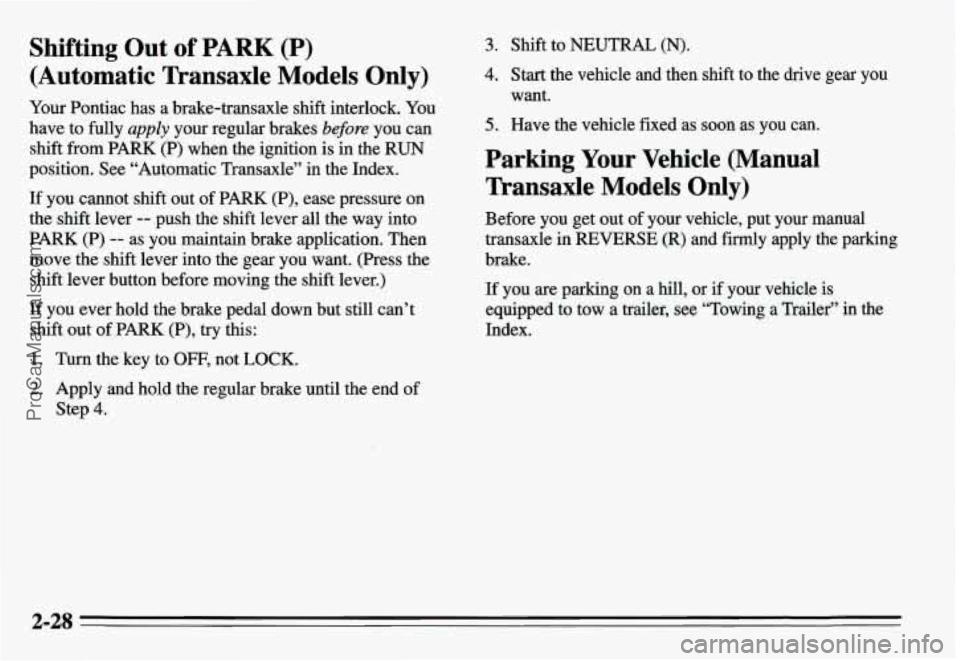
Shifting Out of PARK (P)
(Automatic Transaxle Models Only)
Your Pontiac has a brake-transaxle shift interlock. You
have to fully appZy your regular brakes before you can
shift from PARK (P) when the ignition is in the RUN
position. See “Automatic Transaxle” in the Index.
If you cannot shift out of PARK (P), ease pressure on
the shift lever
-- push the shift lever all the way into
PARK
(P) -- as you maintain brake application. Then
move the shift lever into the gear you want. (Press the
shift lever button before moving the shift lever.)
If you ever hold the brake pedal down but still can’t
shift out of PARK (P), try this:
1. Turn the key to OFF, not LOCK.
2. Apply and hold the regular brake until the end of
Step 4.
3. Shift to NEUTRAL (N).
4. Start the vehicle and then shift to the drive gear you
want,
5. Have the vehicle fixed as soon as you can.
Parking Your Vehicle (Manual
Transaxle Models Only)
Before you get out of your vehicle, put your manual
transaxle in
REVERSE (R) and firmly apply the parking
brake.
If you are parking on a hill, or if your vehicle is
equipped to tow
a trailer, see ‘Towing a Trailer” in the
Index.
2-28
ProCarManuals.com
Page 94 of 354
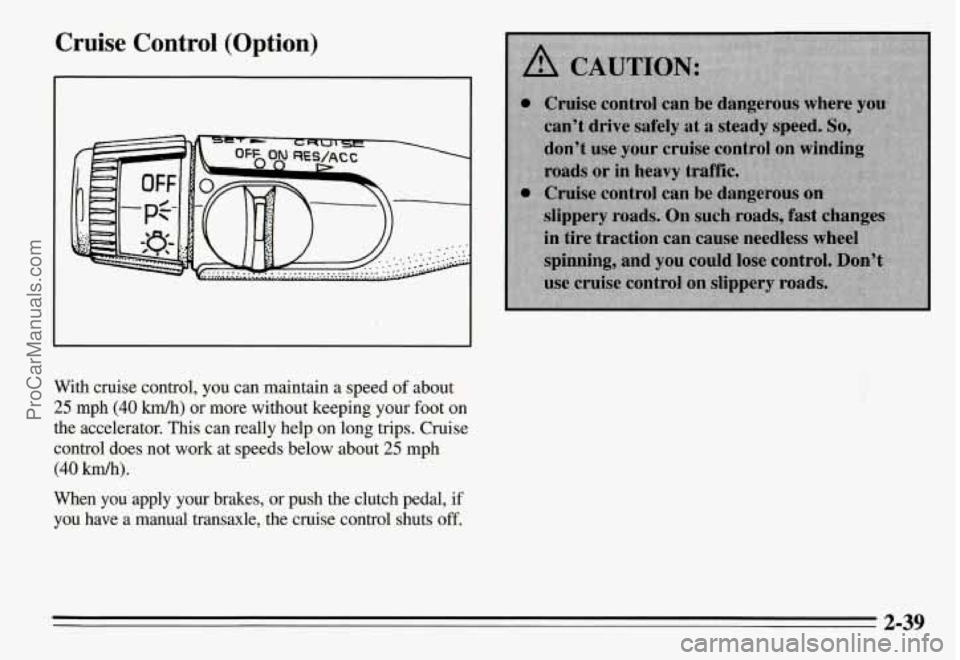
Cruise Control (Option)
With cruise control, you can maintain a speed of about
25 mph (40 km/h) or more without keeping your foot on
the accelerator. This can really help on long trips. Cruise
control does not work at speeds below about
25 mph
(40 km/h).
When you apply your brakes, or push the clutch pedal, if
you have a
manual transaxle, the cruise control shuts off.
2-39
ProCarManuals.com
Page 96 of 354
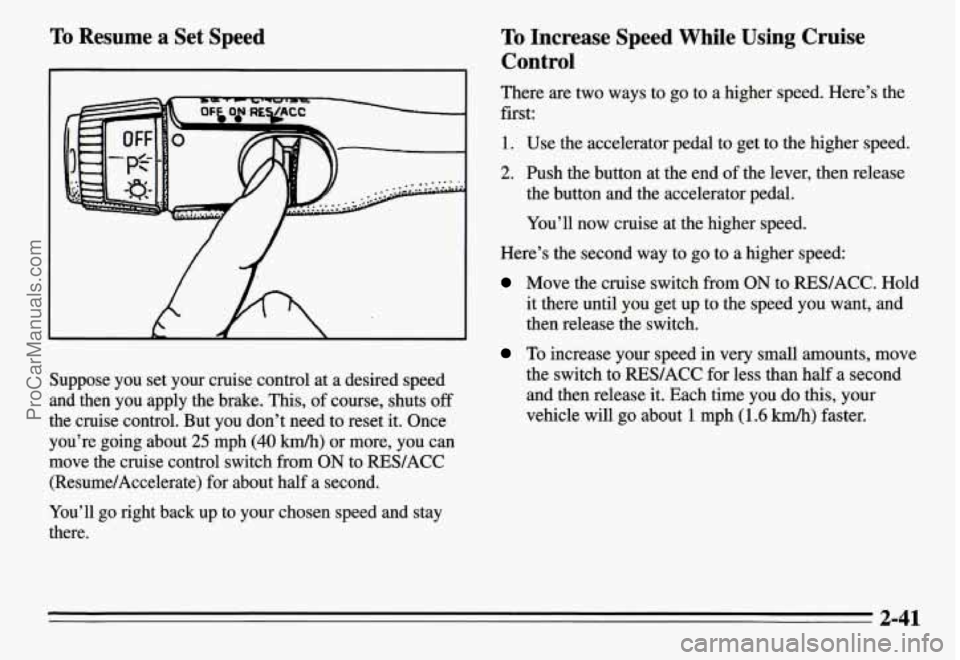
To Resume a Set Speed
Suppose you set your cruise control at a desired speed
and then you apply the brake. This, of course, shuts
off
the cruise control. But you don’t need to reset it. Once
you’re going about
25 mph (40 km/h) or more, you can
move the cruise control switch from
ON to RES/ACC
(Resume/Accelerate) for about half a second.
You’ll go right back up to your chosen speed and stay
there.
To Increase Speed While Using Cruise
Control
There are two ways to go to a higher speed. Here’s the
first:
1. Use the accelerator pedal to get to the higher speed.
2. Push the button at the end of the lever, then release
the button and the accelerator pedal.
You’ll now cruise at the higher speed.
Here’s the second way to go to a higher speed:
Move the cruise switch from ON to RES/ACC. Hold
it there until you get up to the speed you want, and
then release the switch.
To increase your speed in very small amounts, move
the switch to RES/ACC for less than half a second
and then release it. Each time you do this, your
vehicle will go about
1 mph (1.6 km/h) faster.
2-41
ProCarManuals.com
Page 97 of 354
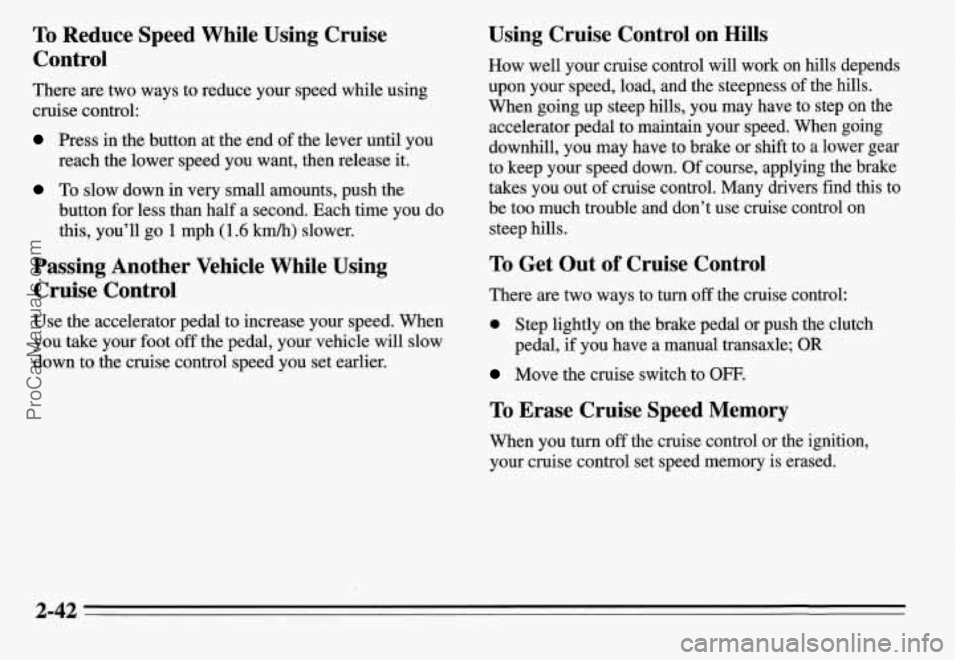
To Reduce Speed While Using Cruise
Control
There are two ways to reduce your speed while using
cruise control:
Press in the button at the end of the lever until you
reach the lower speed
you want, then release it.
To slow down in very small amounts, push the
button for less than half a second. Each time you do
this, you’ll go
1 mph (1.6 km/h) slower.
Passing Another Vehicle While Using
Cruise Control
Use the accelerator pedal to increase your speed. When
you take your
foot off the pedal, your vehicle will slow
down to the cruise control speed you set earlier.
Using Cruise Control on Hills
How well your cruise control will work on hills depends
upon your speed, load, and the steepness of the hills.
When going up steep hills, you may have to step on the
accelerator pedal to maintain your speed. When going
downhill, you may have to brake or shift to a lower gear
to keep your speed down.
Of course, applying the brake
takes you out of cruise control. Many drivers find this to
be too much trouble and don’t use cruise control on
steep hills.
To Get Out of Cruise Control
There are two ways to turn off the cruise control:
0 Step lightly on the brake pedal or push the clutch
pedal, if you have a manual transaxle; OR
Move the cruise switch to OFF.
To Erase Cruise Speed Memory
When you turn off the cruise control or the ignition,
your cruise control set speed memory is erased.
2-42
ProCarManuals.com
Page 98 of 354
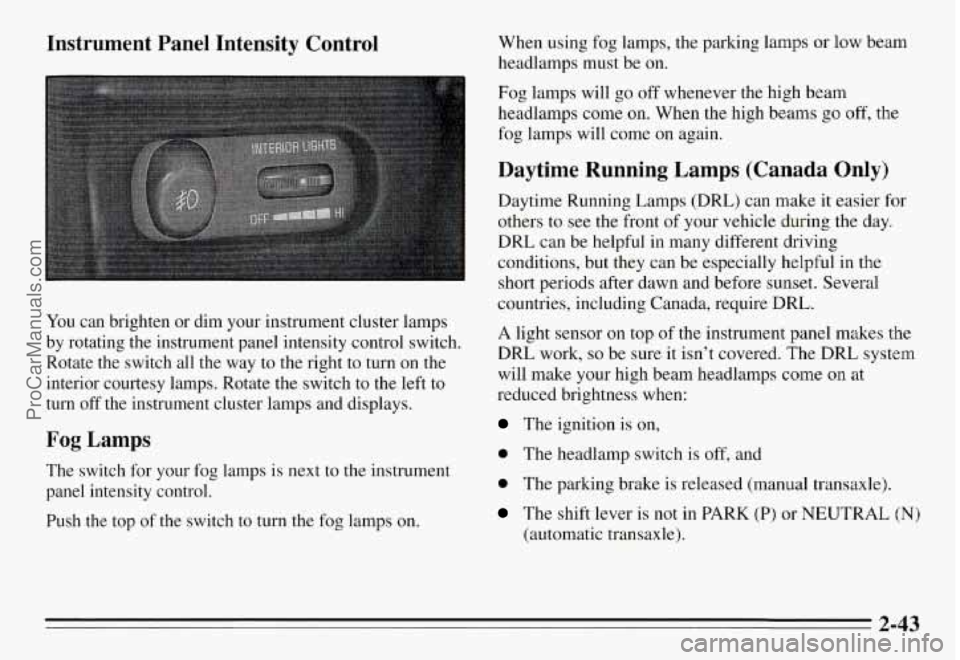
Instrument Panel Intensity Control
You can brighten or dim your instrument cluster lamps
by rotating the instrument panel intensity control switch.
Rotate the switch all the way to the right to turn on the
interior courtesy lamps. Rotate the switch to the left to
turn off the instrument cluster lamps and displays.
Fog Lamps
The switch for your fog lamps is next to the instrument
panel intensity control.
Push the top of the switch
to turn the fog lamps on.
When using fog lamps, the parking lamps or low beam
headlamps must be on.
Fog lamps will go off whenever the high beam
headlamps come on. When the high beams go off, the
fog lamps will come on again.
Daytime Running Lamps (Canada Only)
Daytime Running Lamps (DRL) can make it easier for
others to see the front
of your vehicle during the day.
DRL can be helpful in many different driving
conditions, but they can be especially helpful in the
short periods after dawn and before sunset. Several
countries, including Canada, require
DRL.
A light sensor on top of the instrument panel makes the
DRL work,
so be sure it isn’t covered. The DRL system
will make your high beam headlamps come on at
reduced brightness when:
The ignition is on,
0 The headlamp switch is off, and
0 The parking brake is released (manual transaxle).
The shift lever is not in PARK (P) or NEUTRAL (N)
(automatic transaxle).
2-43
ProCarManuals.com
Page 99 of 354
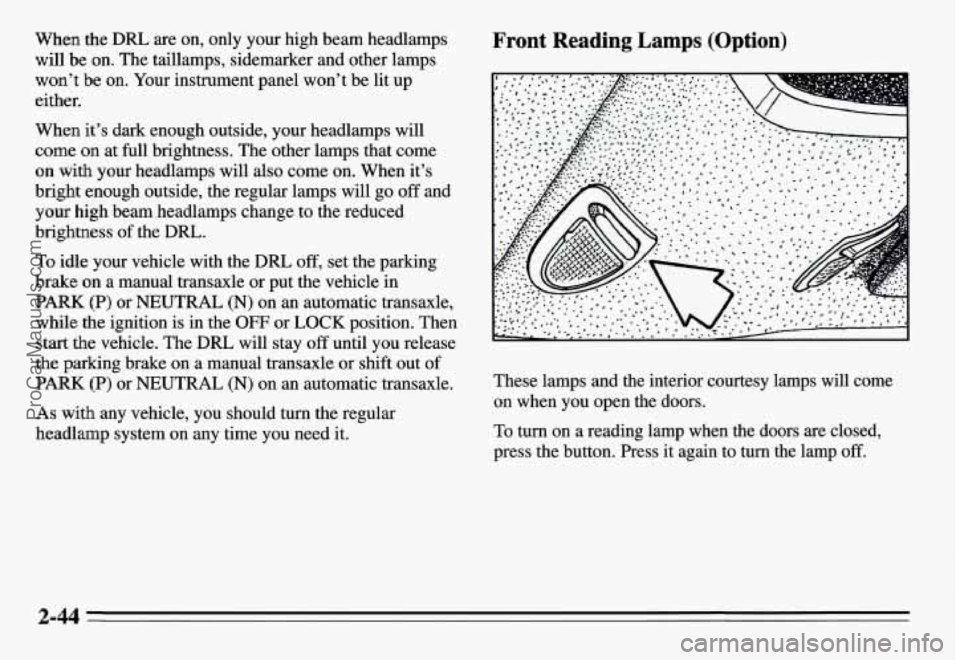
When the DRL are on, only your high beam headlamps
will be on. The taillamps, sidemarker and other lamps
won’t be on. Your instrument panel won’t be lit up
either.
When it’s dark enough outside, your headlamps will
come on at
full brightness. The other lamps that come
on
with your headlamps will also come on. When it’s
bright enough outside, the regular lamps will go
off and
your high beam headlamps change to the reduced
brightness
of the DRL.
To idle your vehicle with the DRL off, set the parking
brake On a manual transaxle or put the vehicle in
PARK (P) or NEUTRAL (N) on an automatic transaxle,
while the ignition is
in the OFF or LOCK position. Then
start the vehicle. The DRL will stay off until you release
the parking brake on a manual transaxle or shift out
of
PARK (P) or NEUTRAL (N) on an automatic transaxle.
As with any vehicle, you should turn the regular
headlamp system on any time you need it.
Front Reading Lamps (Option)
These lamps and the interior courtesy lamps will come
on when you open the doors.
To turn on a reading lamp when the doors are closed,
press the button. Press
it again to turn the lamp off.
2-44
ProCarManuals.com
Page 108 of 354
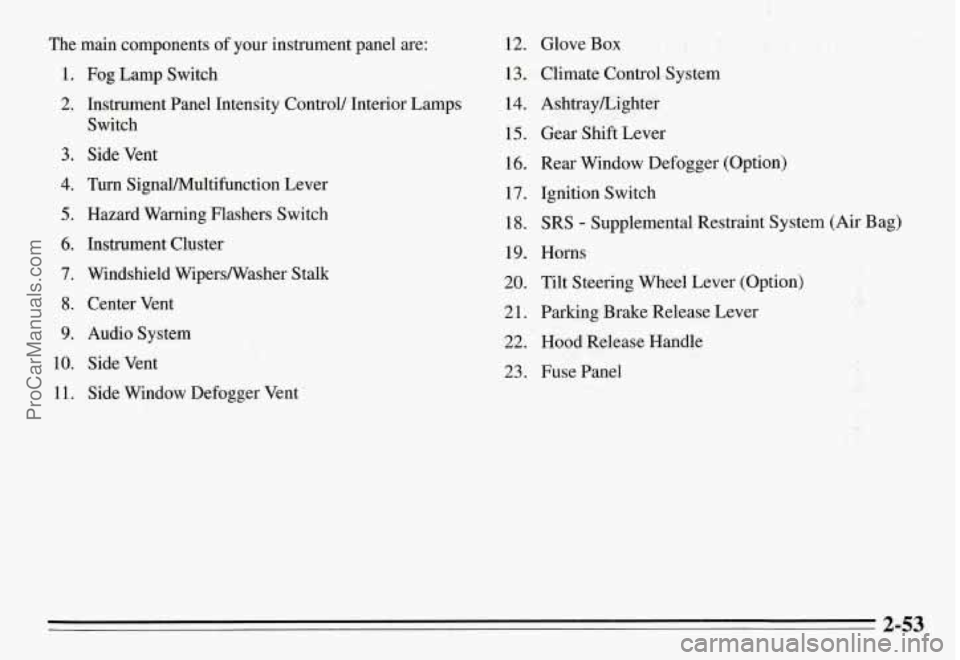
i
The main components of your instrument panel are:
1. Fog Lamp Switch
2. Instrument Panel Intensity Control/ Interior Lamps
Switch
3. Side Vent
4. Turn SignaVMultifunction Lever
5. Hazard Warning Flashers Switch
6. Instrument Cluster
7. Windshield WipersNasher Stalk
8. Center Vent
9. Audio System
10. Side Vent
11. Side Window Defogger Vent
12. Glove Box
13. Climate Control System
14. AshtrayLighter
15. Gear Shift Lever
16. Rear Window Defogger (Option)
17. Ignition Switch
18. SRS - Supplemental Restraint System (Air Bag)
19. Horns
20. Tilt Steering Wheel Lever (Option)
21. Parking Brake Release Lever
22. Hood Release Handle
23. Fuse Panel
2-53
ProCarManuals.com
Page 115 of 354
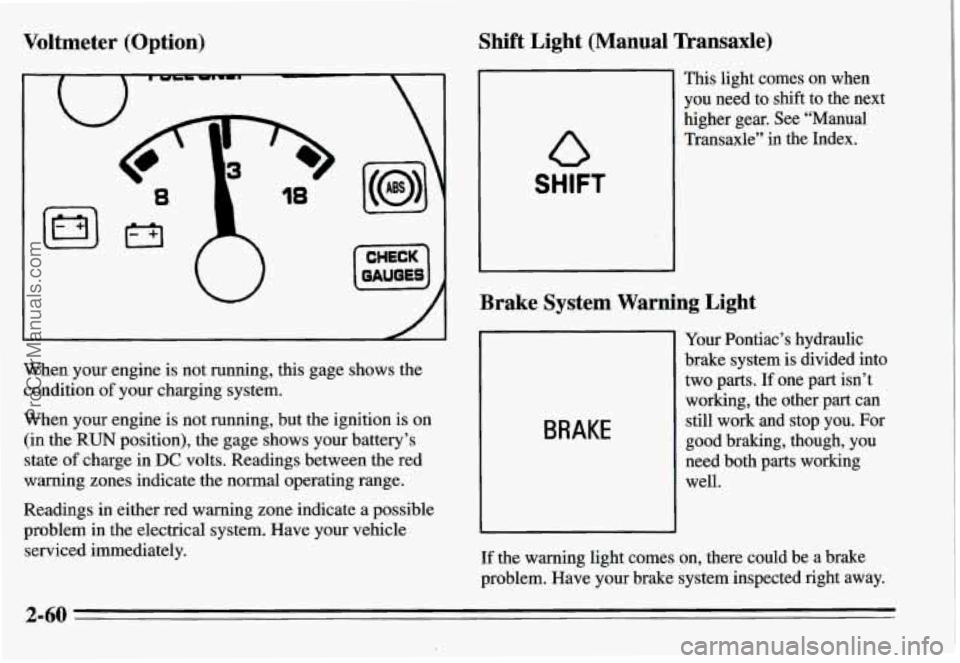
Voltmeter (Option)
U
W
[-I
When your engine is not running, this gage shows the
condition
of your charging system.
When your engine is not running, but the ignition is on
(in the
RUN position), the gage shows your battery’s
state of charge in
DC volts. Readings between the red
warning zones indicate the normal operating range.
Readings in either red warning zone indicate a possible
problem in the electrical system. Have your vehicle
serviced immediately.
Shift Light (Manual Transaxle)
0
SHIFT
L
This light comes on when you need to shift to the next
higher gear. See “Manual
Transaxle” in the Index.
Brake System Warning Light
BRAKE
Your Pontiac .’s hyc h-au llic
brake system is divided into
two parts.
If one part isn’t
working, the other
part can
still work
and stop you. For
good braking, though, you
need both parts working
well.
If the warning light comes on, there could be a brake
problem. Have your brake system inspected right away.
2-60
ProCarManuals.com
Page 116 of 354
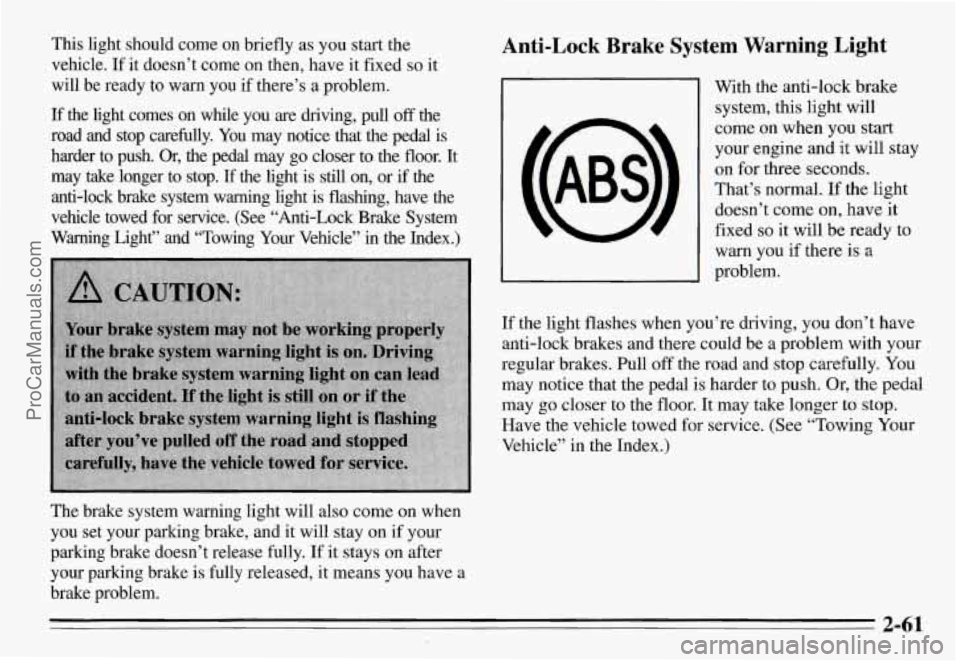
This light should come on briefly as you start the
vehicle. If it doesn’t come on then, have it fixed
so it
will be ready to warn you if there’s a problem.
If the light comes on while you are driving, pull off the
road
and stop carefully. You may notice that the pedal is
harder to push.
Or, the pedal may go closer to the floor. It
may take longer to stop. If the light is still on, or if the
anti-lock brake system warning light is flashing, have the
vehicle towed for service. (See “Anti-Lock Brake System
Warning Light” and “Towing Your Vehicle” in the Index.)
The brake system warning light will also come on when
you set your parking brake, and it will stay
on if your
parking brake doesn’t release fully. If it stays on after
your parking brake is fully released, it means you have a
brake problem.
Anti-Lock Brake System Warning Light
1
With the anti-lock brake
svstem. this lirrht will
8 u
come on when you start
your engine and it will stay
on for three seconds.
That’s normal. If the light
doesn’t come
on, have it
fixed
so it will be ready to
warn you if there is a
problem.
If the light flashes when you’re driving, you don’t have
anti-lock brakes and there could be a problem w-ith your
regular brakes. Pull off the road and stop carefully. You
may notice that the pedal is harder to push.
Or, the pedal
may go closer to the floor. It may take longer to stop.
Have the vehicle towed for service. (See “Towing Your
Vehicle” in the Index.)
2-61
ProCarManuals.com
Page 117 of 354
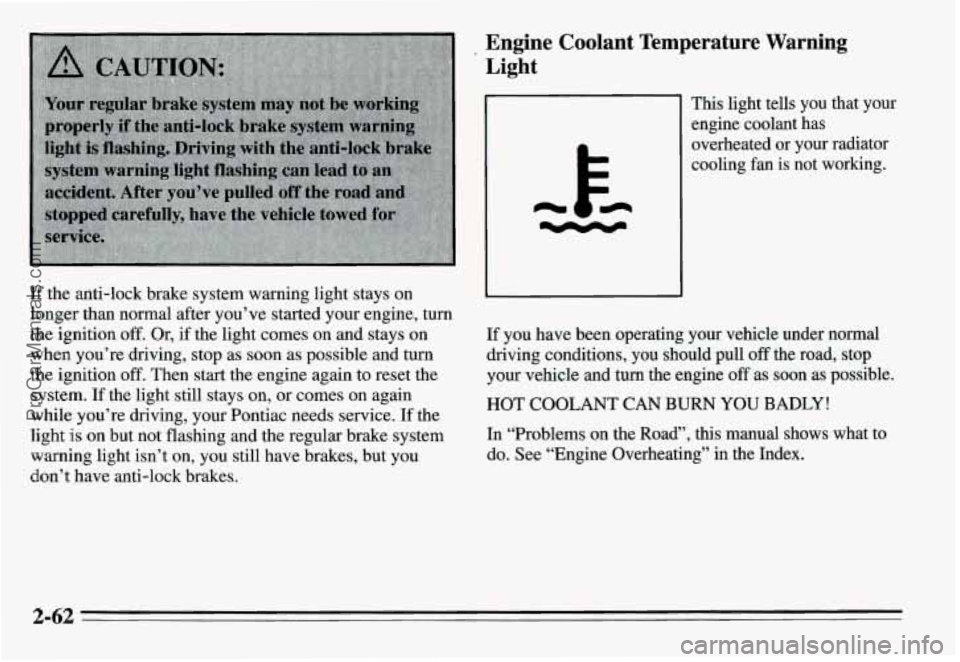
If the anti-lock brake system warning light stays on
longer than normal after you’ve started your engine, turn
the ignition off. Or, if the light comes on
and stays on
when you’re driving, stop as soon as possible and turn
the ignition
off. Then start the engine again to reset the
system. If the light still stays on, or comes on again
while you’re driving, your Pontiac needs service.
If the
light
is on but not flashing and the regular brake system
warning light isn’t on, you still have brakes, but you
don’t have anti-lock brakes.
. Engine Coolant Temperature Warning
Light
This light tells you that your
engine coolant has
overheated or your radiator
cooling fan is not working.
If you have been operating your vehicle under normal
driving conditions, you should pull off the road, stop
your vehicle and turn the engine
off as soon as possible.
HOT COOLANT CAN BURN YOU BADLY!
In “Problems on the Road”, this manual shows what to
do. See “Engine Overheating” in the Index.
2-62
ProCarManuals.com